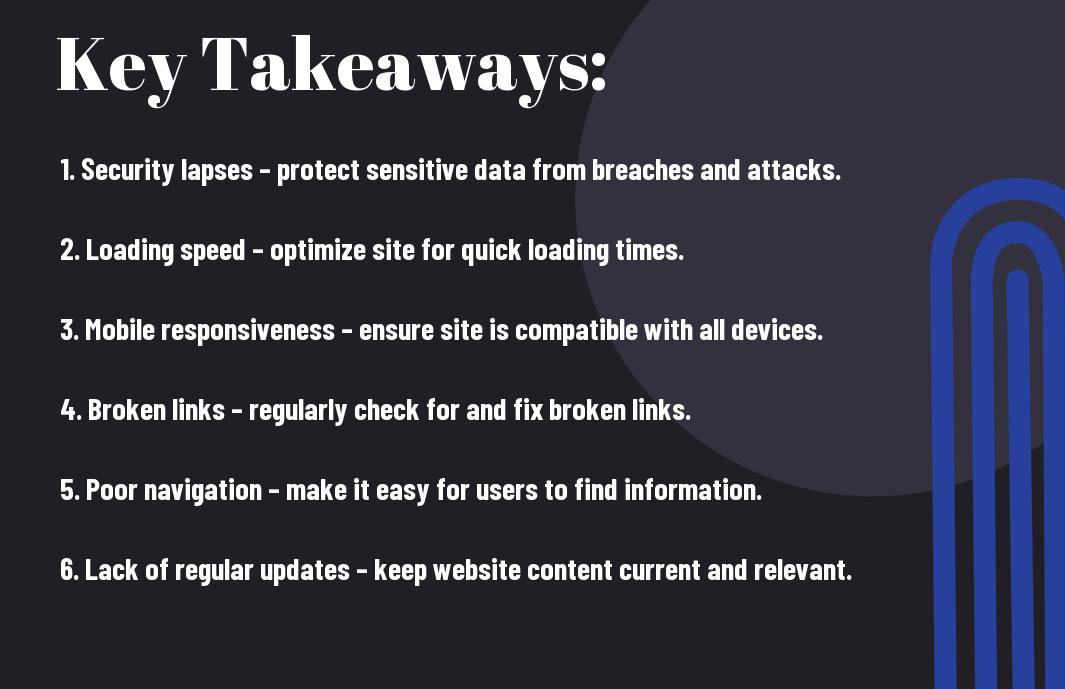As a web developer, you understand the necessity of creating a flawless user experience on your website. However, there are a plethora of common programming mistakes that can not only hinder the functionality of your site but also jeopardize its security. In this informative blog post, we will discuss the most critical website programming mistakes to avoid, including inadequate security measures, poor error handling, improper data validation, and inefficient coding practices. By addressing these issues, you can ensure that your website is not only user-friendly but also safe and efficient. Stay tuned to learn how to optimize your programming skills and elevate the quality of your website programming.
Key Takeaways:
- Lack of Security Measures: Many websites are vulnerable to attacks due to lack of proper security measures. It is essential to regularly update security protocols to protect user data.
- Ignoring Compatibility: Failing to ensure that websites are compatible across different browsers and devices can result in a poor user experience and loss of traffic. Compatibility testing should be a priority in website development.
- Overlooking Loading Speed: Slow loading times can drive users away from a website. Optimizing images, minimizing code, and utilizing caching techniques are crucial for improving loading speed.
- Not Being User-Friendly: Websites that are difficult to navigate or understand can frustrate users. Prioritizing intuitive design and clear navigation can significantly improve user experience.
- Neglecting Mobile Optimization: With the increase in mobile device usage, it is crucial for websites to be optimized for mobile viewing. Failing to do so can result in a loss of mobile traffic and potential customers.

Input Validation Errors
Even minor input validation errors can lead to significant security vulnerabilities on your website. Failing to properly validate and sanitize user inputs can leave your site open to a wide range of attacks.
Failing to Sanitize User Inputs
When you fail to sanitize user inputs, you are allowing potentially harmful code to be injected into your website. This can lead to a variety of security issues, including Cross-Site Scripting (XSS) attacks, SQL injection, and other forms of code injection. By not properly filtering and cleaning inputs from your users, you leave your website vulnerable to exploits that can compromise user data, weaken system security, and diminish your website’s reputation and trust.
Consequences of Cross-Site Scripting (XSS) and SQL Injection
The consequences of Cross-Site Scripting (XSS) and SQL injection can be severe. A successful XSS attack can allow an attacker to execute malicious scripts in the context of your website, potentially stealing user cookies, session tokens, and other sensitive information. SQL injection, on the other hand, can give attackers unauthorized access to your database, allowing them to view, modify, or delete data. Both of these vulnerabilities can have far-reaching consequences, including compromising the integrity and confidentiality of your website and the data it processes. It can also lead to legal repercussions and damage to your brand’s reputation.
It is crucial to properly validate and sanitize user inputs to prevent these devastating security vulnerabilities from being exploited.
Security Vulnerabilities
Unlike other common website programming mistakes, security vulnerabilities can pose a serious threat to your website and user data. Ignoring these vulnerabilities can result in unauthorized access to sensitive information, data breaches, and potential legal consequences. It’s crucial to prioritize security measures in your website programming to protect both your business and your users.
Neglecting HTTPS Protocols
When you neglect to implement HTTPS protocols on your website, you are leaving your users’ data vulnerable to interception and tampering. This can result in sensitive information such as login credentials, payment details, and personal information being exposed to malicious attackers. It’s important to prioritize the use of HTTPS on your website to ensure all data transmitted between the user’s browser and your server is encrypted and secure. Implementing HTTPS also helps build trust with your users and can positively impact your website’s search engine ranking.
Weak Authentication and Session Management
Weak authentication and session management can leave your website vulnerable to unauthorized access and account takeover. If you use weak or predictable passwords, do not enforce strong password policies, or improperly manage user sessions, you are putting your website and user accounts at risk. It’s crucial to implement secure authentication methods such as multi-factor authentication and enforce proper session management to protect user accounts from unauthorized access. Failing to do so can result in compromised user accounts, data breaches, and damage to your reputation.
Performance and Optimization Pitfalls
Keep in mind that a poorly optimized website can negatively affect user experience and could deter potential visitors. To prevent this from happening, it’s crucial to pay attention to the performance and optimization of your website. For more in-depth information on website development, you can check out this helpful article 7 Mistakes to Avoid While Developing a Website.
Inefficient Database Queries
One common performance pitfall is inefficient database queries. This can lead to slow page load times and poor overall website performance. Make sure to index your database tables appropriately and use efficient query syntax. Additionally, consider utilizing caching mechanisms to reduce the number of database calls and improve website response times. Regularly monitoring and optimizing database queries is crucial for maintaining a high-performing website.
Overlooking Mobile Responsiveness and Load Times
Another critical aspect of website performance is mobile responsiveness and load times. With the growing number of mobile users, it’s imperative to ensure that your website is optimized for various mobile devices. Ignoring mobile responsiveness can lead to a frustrating user experience and deter potential visitors. Additionally, slow load times can significantly impact your website’s performance and SEO ranking. Make sure to optimize images, utilize responsive design, and minimize HTTP requests to improve load times. Ignoring mobile responsiveness and load times can lead to missed opportunities and drive users away from your website.
Poor Code Structure and Practices
Despite its importance, many developers neglect the significance of maintaining a well-structured and well-organized codebase for their website. Poor code structure and practices can lead to a myriad of issues, including difficulty in maintaining and updating the website, decreased performance, and increased vulnerability to security threats. It’s important to recognize and rectify these mistakes to ensure the long-term success and functionality of your website.
Lack of Code Comments and Documentation
One common mistake in website programming is the lack of code comments and documentation. When you fail to add comprehensive comments and documentation to your code, you make it challenging for yourself and other developers to understand and modify the code in the future. This can lead to inefficiency in troubleshooting and maintaining the website, ultimately impacting its functionality and performance.
Not Adhering to Coding Standards
Another prevalent mistake is not adhering to coding standards. When you do not follow established coding standards, you compromise the readability and maintainability of your code. This can result in inconsistencies across the codebase, making it difficult to collaborate with other developers and leading to errors and bugs. By adhering to coding standards, you ensure that your code is uniform, clean, and easier to work with, ultimately improving the overall quality of your website.
Ignoring SEO and Accessibility
Now, when it comes to developing a website, it’s essential to remember that simply having a visually appealing site is not enough. You need to ensure that your website is optimized for search engines and accessible to all users, including those with disabilities. Ignoring SEO and accessibility can significantly impact the visibility and usability of your website; it can also lead to legal issues if you fail to comply with accessibility standards. To avoid common web design mistakes related to SEO and accessibility, you can refer to 23 Common Web Design Mistakes To Avoid In 2023.
Overlooking Meta Tags and Structure
One common mistake when it comes to SEO is overlooking the importance of meta tags and website structure. Meta tags, including title tags, meta descriptions, and header tags, play a crucial role in helping search engines understand and index your website. Ignoring these elements can negatively impact your site’s visibility, making it more challenging for users to find you through search engines. It’s essential to optimize your meta tags and website structure to improve your website’s search engine ranking and overall visibility.
Non-Compliant with Web Content Accessibility Guidelines (WCAG)
When it comes to accessibility, many websites overlook the importance of complying with Web Content Accessibility Guidelines (WCAG). Failure to adhere to these guidelines can make your website inaccessible to users with disabilities, including those with visual, auditory, and motor impairments. By ensuring that your website is compliant with WCAG, you can make your site more inclusive and accessible to all users. This not only enhances the user experience but also demonstrates your commitment to creating an inclusive online environment.

Common Website Programming Mistakes to Avoid
Drawing together the information presented in this article, it is crucial for you to be aware of the common website programming mistakes to avoid. By understanding the potential pitfalls, such as inefficient code, lack of security measures, and poor user experience, you can ensure that your website is optimized for performance, functionality, and usability. By being mindful of these common mistakes and actively working to avoid them, you can set yourself up for success in creating a high-quality, professional website that effectively meets the needs of your users.
FAQ
Q: What are some common website programming mistakes to avoid?
A: Some common website programming mistakes to avoid include using inline styles and not optimizing images for web, not using proper error handling, not writing secure code, and not testing for cross-browser compatibility.
Q: How can using inline styles be a programming mistake?
A: Using inline styles can make the code harder to maintain and update, as styles are scattered throughout the HTML rather than being centralized in a separate CSS file. It can also lead to code duplication and larger file sizes.
Q: Why is it important to optimize images for the web?
A: Optimizing images for the web is important for improving website performance and reducing load times. Large, uncompressed images can slow down a website and negatively impact user experience.
Q: What does it mean to write secure code?
A: Writing secure code involves following best practices for web security, such as validating input to prevent SQL injection and cross-site scripting attacks, using secure communication protocols (HTTPS), and implementing proper authentication and authorization mechanisms.
Q: Why is testing for cross-browser compatibility important?
A: Testing for cross-browser compatibility ensures that a website looks and functions consistently across different web browsers and devices. Failing to do so can result in a poor user experience for visitors using browsers other than the one the website was developed on.
